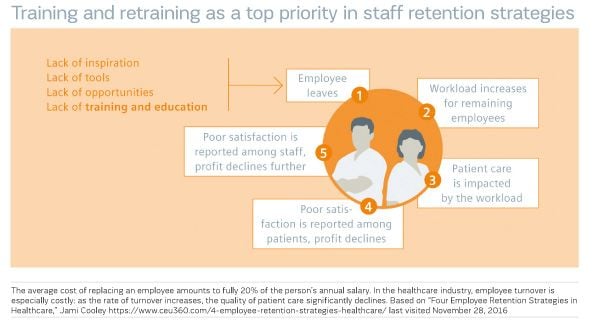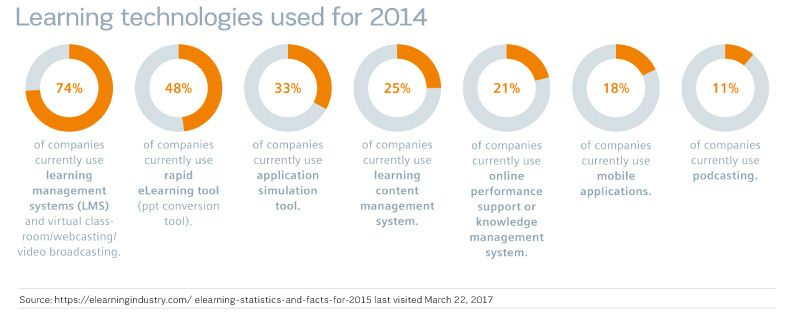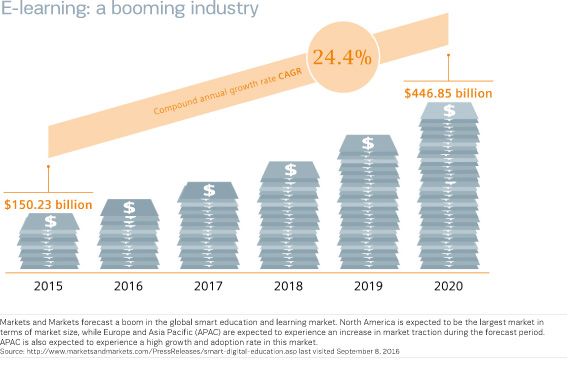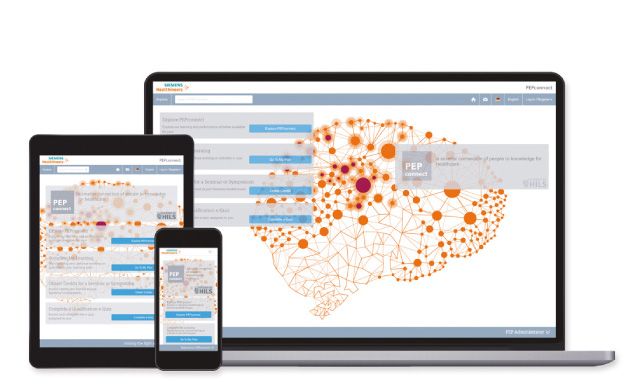HealthManagement, Volume 17 - Issue 2, 2017
Offering healthcare professionals high-quality continuous education means leveraging excellence in healthcare performance.
The healthcare industry is demonstrating high growth rates in both developing and developed regions around the world. The Bureau of Labor Statistics (BLS) projects that the healthcare and social assistance sector will grow at an annual rate of 2.6% between 2012 and 2022, adding five million jobs.1 But will the people filling these vacancies be the highly skilled and motivated staff members the healthcare sector is longing for so urgently? According to a PWC survey, healthcare CEOs see availability of skilled staff as one of their top five key risks.
Continuous education in healthcare is key
Even though 75% of CEOs worldwide say that a skilled, educated, and adaptable workforce should be a government/business priority2, there’s a growing lack of experienced and well-trained staff in the healthcare environment in many regions around the globe. To counter this trend, there’s a need to raise awareness that education doesn’t come to an end once people are in the middle of their professional career. Because the healthcare industry is continuously evolving, technologies considered best practice today can change drastically in just the span of a decade. That’s why care providers have to regularly keep up with new techniques and technologies and expand their knowledge and skills – which means continuous education is not a nice-to-have but an absolute necessity for any healthcare professional who wants to provide high-quality patient care.
"WITH ACCELERATING ADVANCES IN HEALTH INFORMATION AND TECHNOLOGY, PHYSICIANS, NURSES, AND OTHER HEALTH PROFESSIONALS MUST MAINTAIN AND IMPROVE THEIR KNOWLEDGE AND SKILLS THROUGHOUT THEIR CAREERS. THAT'S THE ONLY WAY TO PROVIDE SAFE, EFFECTIVE, AND HIGH-QUALITY HEALTHCARE FOR THEIR PATIENTS."
Dr. med. Janina Beilner,
Vice President Application Services, responsible for global training and education at Siemens Healthineers Services


Highly skilled and educated staff always pays off
The advantages of investing into continuous education are obvious: highly skilled staff, high staff retention, magnificent reputation, optimized financial performance, better patient outcomes, less medical malpractice lawsuits. The disadvantages are equally obvious: By not investing into their personnel, medical institutions risk losing their experts to other employers. And losing out on valuable knowledge gains can lead to inefficient system usage, frustrated users, and dissatisfied patients – and consequently to higher costs, wasted time, and image loss. So this raises the question: Why isn’t every medical institution integrating continuous education into their everyday quality landscape? Maybe because continuous education is still mentally linked with employees being away, course fees, travelling and accommodation costs, and more.
The concept of learning is changing
The era of pure classical classroom trainings is definitely over. Based on lectures, the traditional approach involves time away and means that not every staff member has access to the same learning content. Our time is the era of flexible e-learning for continuous education. It allows the entire staff to gain the same level of knowledge directly at their workplace – and enables every member to deliver safe, effective, and high-quality patient care.
"IT’LL ALLOW ME TO CONTINUALLY ASSESS AND GUARANTEE THAT EVERYBODY IN THE LAB, 24/7, ALL THE DIFFERENT SHIFTS AND STAFF LEVELS – WHETHER FULL, PART TIME OR PER DIEM EMPLOYEES – HAVE THE SAME LEVEL OF COMPETENCY."
Marilyn A. Leonard,
ASCP Supervisor, White Plains Hospital. White Plains, NY, USA
Solving time and cost issues with e-learning
We all know that the medical profession is knowledge driven and staying up to date is crucial. But we also know that it’s a very busy environment and time for education is scarce. For many hospitals and practices it’s also a challenge to send employees to training centers because of budget cuts and understaffing. Sending employees to attend training courses for a few hours or even days can make work planning a challenge. And with colleagues having to stand in, it also creates overtime. E-learning helps institutions of any size solve these issues, by allowing caregivers to train more efficiently at their convenience and without having to leave work – also curbing costs.

E-learning fits today’s learning and information Needs
It’s a fact that people nowadays are very mobile and spend more time online than ever before – and this lifestyle trend is growing. That’s one of the reasons e-learning is a booming industry. Consequently, the e-learning market in healthcare will also continue to grow. Because when it comes to learning and information needs, medical professionals (like everyone else) will first turn to online platforms – providing the content is valuable and up to date.
E-learning is more effective than other forms of trainings
Continuous education with e-learning can help keep learners’ interest and motivation up because the learning units can be enhanced with videos or interactive elements. These can be paused and continued later on; or repeated until the participant has fully grasped its essential. Latest evidence also suggests that e-learning is more efficient in most cases because learners gain knowledge, skills, and attitudes faster than through traditional instructor-based methods – translating into improved motivation and performance.3

Various learning technologies for e-learning
The learning technologies used for e-learning are diverse. They include webcasts, application simulation tools, learning content management systems, per formance support, mobile applications, podcasts, and more. They’re all well received by the users, and employers are more and more inclined to make use of the latest technological developments. In fact, more than ever, learners and companies are turning to e-learning courses and online training events to achieve their personal and professional goals.4
Staying on top of chances and advancements – with e-learning
One way to always stay on top of the rapidly changing and growing healthcare market is to implement a business strategy that maximizes the synergies between life-long learning and workforce productivity. Research has shown that e-learning proves to be an excellent way to achieve quality results in a short timeframe. Learning which is delivered online, within the context of continuous education, should therefore be considered a strategic part of training and education plans for healthcare professionals.
In a nutshell:
Learning is a continuous process, not an episodic event.
Continuous learning is key to success
The healthcare industry is a very competitive environment, and clinical institutions have to deliver an ever higher quality of care – while staying within budget. A skilled and motivated staff that’s always up-to-date with the latest developments in techniques and technologies is a huge competitive advantage. According to Deloitte’s Human Capital Trends survey from 2016, senior executives see learning on the 5th place within their top 10 trends – with 84% of the responders saying learning is very important/important for them.5
E-learning …
- keeps staff up-to-date regarding the latest developments
- has a positive impact on healthcare organizations by helping them be consistent with legal demands and new patient populations through highly educated staff
- reduces training budgets and costs
- makes human resources, recruiting, selection, and onboarding more manageable
- is a modern learning approach, based on the latest technologies
Download or request free copies of our white papers on continuous education and e-learning at healthcare.siemens.com/education/pep

Professional essay writing services to write my essays for me.
References:
- http://explorehealthcareers.org/en/issues/news/Article/339/What_Will_the_Health_Care_Job_Market_Look_Like last visited November 28, 2016
- Source: PwC, 19th Annual Global CEO Survey, January 2016
- http://www.formatex.info/ict/book/147-153.pdf last visited September 8, 2016
- https://elearningindustry.com/elearning-statistics-and-facts-for-2015 last visited March 22, 2017
- Deloitte Global Human Capital Trends 2016: Graphic: Deloitte University Press, DUPress.com

